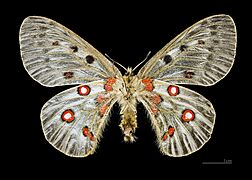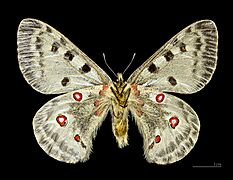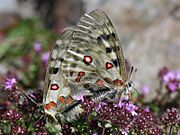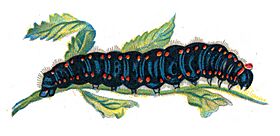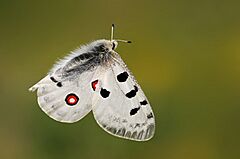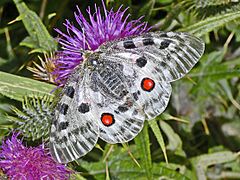Mountain Apollo facts for kids
Quick facts for kids Apollo |
|
|---|---|
 |
|
| Parnassius apollo. Upperside | |
 |
|
| Underside | |
| Conservation status | |
| Scientific classification | |
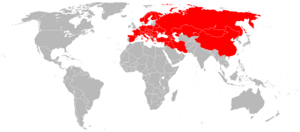 |
|
| Distribution map |
The Apollo butterfly (Parnassius apollo) is a beautiful butterfly that lives in the mountains. It belongs to the Papilionidae family, which includes many large and colorful butterflies.
Contents
What's in a Name?
This butterfly is named after Apollo, a god from ancient Greek and Roman stories. It's a common tradition to name species after figures from classical mythology.
Different Kinds of Apollo Butterflies
There are many different types, or subspecies, of the Apollo butterfly. Each type often lives in a specific area, like a certain mountain range or valley. For example, the Parnassius apollo gadorensis used to live in the Sierra de Gádor mountains in Spain, but it is now extinct.
Where Do They Live?
The Apollo butterfly loves mountains! It lives in hills and flowery meadows high up in the European mountains. You can find it in places like Spain, Scandinavia, Central Europe, the Balkans, and the Alps. It also lives in some parts of Central Asia.
These butterflies usually live at high altitudes, from about 400 meters (1,300 feet) up to 2,300 meters (7,500 feet) above sea level. They are most common above 1,000 meters (3,300 feet).
Apollo butterflies need special weather conditions: cold winters and sunny summers. They also need wide-open spaces with lots of grass and not too many bushes. It's very important for them to have the right plants for their caterpillars to eat.
What Do They Look Like?
Male Apollo butterflies have a wingspan (how wide their wings are) of about 62 to 86 millimeters (2.4 to 3.4 inches). Females are a bit larger, with wingspans from 65 to 95 millimeters (2.6 to 3.7 inches).
These butterflies are mostly white and very noticeable. They have five large black spots on their front wings. On their back wings, they have two bright red or sometimes orange spots that look like eyes. These red spots can change in size and shape depending on where the butterfly lives. Over time, the sun can make the bright red color fade to orange.
The edges of their wings are a bit see-through. Some Apollo butterflies are darker than others. The caterpillars of this species are velvety black with orange-red spots along their sides.
Other butterflies that are related to the Apollo include the clouded Apollo (Parnassius mnemosyne), which lives in valleys, and the small Apollo (Parnassius phoebus), which lives in high mountains.
Why Are There Different Colors?
Long ago, during the Ice Age, big glaciers separated groups of Apollo butterflies. This made them live in different areas, and over time, their colors changed slightly. The butterflies became isolated in different parts of Europe and Asia.
Even within these separate groups, there are differences in wing color. The size of the butterflies can also vary between these isolated groups. Larger groups, called metapopulations, can support more butterflies because they have more resources.
How Do Changes Affect Their Survival?
New challenges in the environment can cause certain color types to survive better. However, a lot of color variation can sometimes lead to more extinctions. For example, in the Swiss Alps, where there's a lot of variation, many Apollo butterflies are disappearing.
One big reason for this is the warming climate. Apollo butterflies are used to cold mountain weather. As the climate gets warmer, they find it harder to adapt.
Another problem is how their food plants are spread out. If the plants that the caterpillars eat are too far apart, the butterflies might not be able to travel between them to lay eggs. This can make their populations shrink.
Life Cycle of the Apollo Butterfly
The Apollo butterfly has one generation each year. Adult butterflies fly from May to September. They drink nectar from flowers.
When mating, the male butterfly leaves a special jelly-like substance called a sphragis on the female. This stops her from mating with other males. The females then lay eggs, which stay through the winter and hatch in the spring.
The Apollo caterpillar is velvety blue-black with small orange spots. These caterpillars eat plants like stonecrop (Sedum species) and houseleek (Sempervivum species). Once the caterpillar is fully grown, it forms a loose cocoon on the ground. Inside, it changes into an adult butterfly.
How They Protect Themselves
Apollo butterflies have several ways to protect themselves from predators. When they are young caterpillars, they are completely black, which helps them blend in. But as they grow, they develop orange spots, making them easier to see.
These caterpillars also share a defense with a type of millipede called Glomeris guttata. Both the caterpillars and the millipedes have orange spots and black bodies, and they live in the same places. They both release a bad-smelling liquid to scare away animals that might want to eat them.
Once the butterfly is an adult, it has bright eye-like spots on its wings. These spots are circles of different colors. Scientists think these spots might:
- Look like the eyes of a predator's enemy to scare them.
- Draw the predator's attention to parts of the butterfly that are not vital.
- Simply surprise the predator.
The only downside is that these spots make the butterfly more noticeable.
Another defense is their taste. Like the monarch butterfly, the Apollo butterfly tastes bad to predators. They get this bad taste from the plants they eat, like Sedum stenopetalum. There's a bitter chemical called sarmentonsin in both the plant and the butterfly. The wings have a lot of this chemical, so they taste worse than the rest of the body. Some birds, like water pipits, have learned to remove the wings before eating the butterfly's body.
Protecting the Apollo Butterfly
Scientists are very interested in the Apollo butterfly because there are so many different types, often found in just one valley in the Alps. People who collect butterflies have always wanted to have as many of these different types as possible. While too much collecting has caused their numbers to drop in some areas, like Spain and Italy, changes to their habitat are a much bigger threat.
When forests of pine trees are planted, or when their grassy homes turn into bushy areas, or when land is used for farming or cities, the Apollo butterfly loses its home. Climate change and acid rain have also caused their numbers to go down in northern Europe. Even cars on roads have been known to kill many Apollo butterflies.
In Finland, the Apollo was one of the first insects to be called endangered. Its numbers in Finland and Sweden dropped a lot in the 1950s. No one knows exactly why, but some think it might have been a disease or related to acid rain, as they now mostly live in areas with limestone in the ground.
Many countries have laws to protect the Apollo butterfly. It is listed on the IUCN Red List of Threatened Species, which is an important list of animals at risk. It's also protected by international agreements like CITES and the Habitats Directive. Other countries like Liechtenstein, the Czech Republic, Turkey, and Poland also protect it.
However, these laws often protect individual butterflies, not their homes. This means they might not do enough to help the biggest problem the butterflies face. Luckily, there are projects working to save this vulnerable insect. In Pieniny National Park in Poland, a special program helped save a type of Apollo butterfly that had only 20 individuals left in the early 1990s. They did this by breeding butterflies in captivity and protecting their habitat. In Germany, conservationists work with shepherds to make sure the grasslands are good for the butterflies and the sheep. For example, they change when the sheep graze so they don't accidentally step on the young caterpillars.
Many types of Apollo butterflies in Europe are decreasing in number. This is mainly because their homes are being destroyed, air pollution affects the plants they eat, and butterfly collectors. The Apollo butterfly is also more at risk from predators because it spends two years as a caterpillar.





